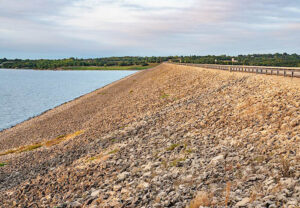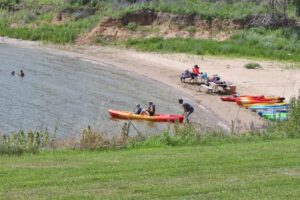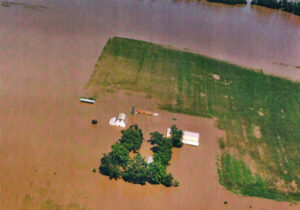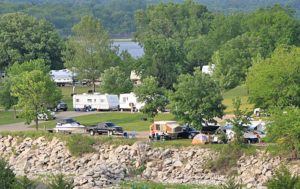Milford Lake, also known as Milford Reservoir, is the largest man-made lake in Kansas, with 15,709 acres of water. Over 33,000 acres of land resources are managed for quality recreational experiences and for protecting the project’s natural and cultural resources.
Milford State Park, a favorite getaway for outdoors-loving visitors, is located on the lake’s southeast shore. Called the Fishing Capitol of Kansas, it is a popular destination for anglers eager for walleye, crappie, wipers, large-mouth and smallmouth bass, white bass, and blue and channel catfish. The current Kansas record Smallmouth Bass (6.88 Pounds) was caught at Milford Lake. It has been nationally recognized and has hosted some of America’s most prestigious fishing tournaments.
The lake has 163 miles of shoreline, where visitors enjoy sandy swimming beaches, and 14 public ramps for launching boats, canoes, or sailboats. The lake has public and private campgrounds, a resort, RV sites, cabins, and primitive camping sites.
Approximately 70% of the land resources are available for public hunting, where a variety of game, including quail, pheasant, prairie chicken, duck, goose, rabbit, turkey, deer, and squirrel can be found. Trappers are also active throughout the season in pursuit of raccoons, muskrats, beavers, and other furbearers.
There are many opportunities to observe or photograph wildlife on the 19,000-acre wildlife area located on the west side and upper end of the reservoir. The Steve Lloyd Refuge contains an additional 1,100 acres. The diverse habitats support many nongame birds, mammals, reptiles, and aquatic life species. Nearby Milford Nature Center and Milford Fish Hatchery — both are located below the dam — offer a variety of interpretive exhibits and displays. The lake hosts a large influx of bald eagles in the winter.
Long before Milford Dam was built, early Native Americans talked of a great flood in 1781. However, the 1849 flood was one of the first significant floods reported by early European settlers. The flood caused immense herds of buffalo to be drowned and washed up into the tops of trees along the rivers. Due to a heavy frost immediately following, the buffalo carcasses were preserved long enough for the flood survivors to eat well until the spring thaw. In the spring, when the carcasses began to rot, it was suspected that they were the cause of a cholera outbreak.
The flood of 1869 caused a significant loss of life. Reports were given of entire families being washed away while a few survivors clung to the tops of trees for hours, hoping to be saved. One story told of an infant who was tied up in a man’s shirt and then tied to a tree surrounded by water to await rescue. Due to the swift current, nearby rescuers unable to take action were forced to listen to the child’s cries for five hours. Finally, when they were able to come back in a boat to rescue the child, it took all the extra men available to hold a rope tied to the boat to keep the boat from swamping and being washed away.
The 1935 flood recorded the highest combined flow for the Republican and Smoky Hill Rivers. These two rivers meet within the city limits of Junction City, Kansas, and form the Kansas River. Hours before, a cloudburst had occurred at McCook, Nebraska, sending a wall of water down the Republican River. Eight boxcars were turned over at Milford, Kansas, and the Union Pacific Railroad Depot was washed off its site. Near Alida, Kansas, the Republican River cut a new channel north of town. After the floodwater receded, there was talk of straightening the river channel.
The Great Flood of 1951 was the last major flood in the area before the Milford Dam was built. It reportedly caused a combined total of $6,500,000 in flood damages in the Fort Riley and Junction City area. After the 1951 disaster, the local newspapers were filled with articles requesting the federal government to intercede and build dams along the Republican, Smoky Hill, and Big Blue Rivers.

The Milford Dam creates the Milford Reservoir on the Republican River near Junction City, Kansas. Photo courtesy Wikipedia.
The creation of Milford Lake was authorized by the Flood Control Act of 1954 to provide flood control, water supply, water quality, navigation, and recreation/wildlife. Construction of the Milford Dam began July 13, 1962, at mile 8.3 of the Republican River, as a project owned and operated by the United States Army Corps of Engineers. The initial construction cost of the dam and reservoir was approximately $49,700,000.
The dam consists of a rolled earth-fill embankment of 15 million cubic yards without spillway gates on the right bank. Normal water storage impounds 388,000 acre-feet.
Many contractors were involved with the project during the construction phase. Contractors built new roads, altered existing roadways, relocated railroad facilities, city-owned facilities in Wakefield and Milford, electrical, telephone, and gas lines, and cemeteries. They also built recreation areas and cleared structures within the reservoir flood pool.
The towns of Alida in Geary County and Broughton in Clay County ceased to exist, with houses either moved to other locations, razed, burned, or buried.
The community of Alida had a major clearing contract for removing the Alida Cooperative grain elevator. Initially, a local man sought permission to develop the grain elevator into a hotel with a restaurant. However, Corps of Engineers studies showed that the base of the elevator would not support the structure after the lake inundated it. According to local newspaper articles, bringing the elevator down took six separate blasts over two days.
The community of Broughton had two railroads that came through the town, the Rock Island from the east and the Union Pacific from the southeast. The town had a stockyard, grain elevator, post office, school, church, telephone exchange, grocery store, private homes, and a blacksmith’s shop under a large cottonwood tree. According to a local newspaper article, many men living there worked for the railroads. Even though the community is gone, an annual Broughton picnic is held for those who still remember.
Portions of the cities of Wakefield in Clay County and Milford in Geary County were relocated to higher ground. Farms were dismantled, and trees were removed from areas soon to be covered by the lake waters.
Impoundment of the lake began on January 16, 1967, and six months later, on July 13, the multipurpose pool elevation of 1,144.4 feet above mean sea level was reached. A dedication ceremony was held in May 1968.
In 1993, well above average rainfalls had occurred throughout the entire Midwest for several months, and the ground was saturated, unable to soak up the continuing rainfall. Rivers and levees were full, keeping the rising waters in check. It continued to rain. Lakes along the upper and lower Missouri River Basin closed their gates so as not to add to the flooding that was beginning further downstream. The rain continued until the rivers, levees, and lakes could hold no more, and the Great Flood of 1993 went underway, with flooding of a magnitude not seen since 1951. Many locals involved with fighting the flood agree that 1993 would have been much worse than the 1951 flood without the protection offered by the Milford Dam. Although flooding could not be stopped entirely, the dam system and other flood protection work lessened the loss of life and property.
Over the last 34 years, the Milford Lake Project has provided over $921 million in flood prevention, including $250 million during the 1993 fiscal year (Oct. 1, 1992 – Sept. 30, 1993).
The lake and state park are located northwest of Junction City, Kansas, in the rolling Kansas Flint Hills, west of K-77 on K-5.
©Kathy Alexander/Legends of Kansas, updated June 2025.
Also See:
Sources:
Junction City, Kansas
Kansas Department of Wildlife
Wikipedia




